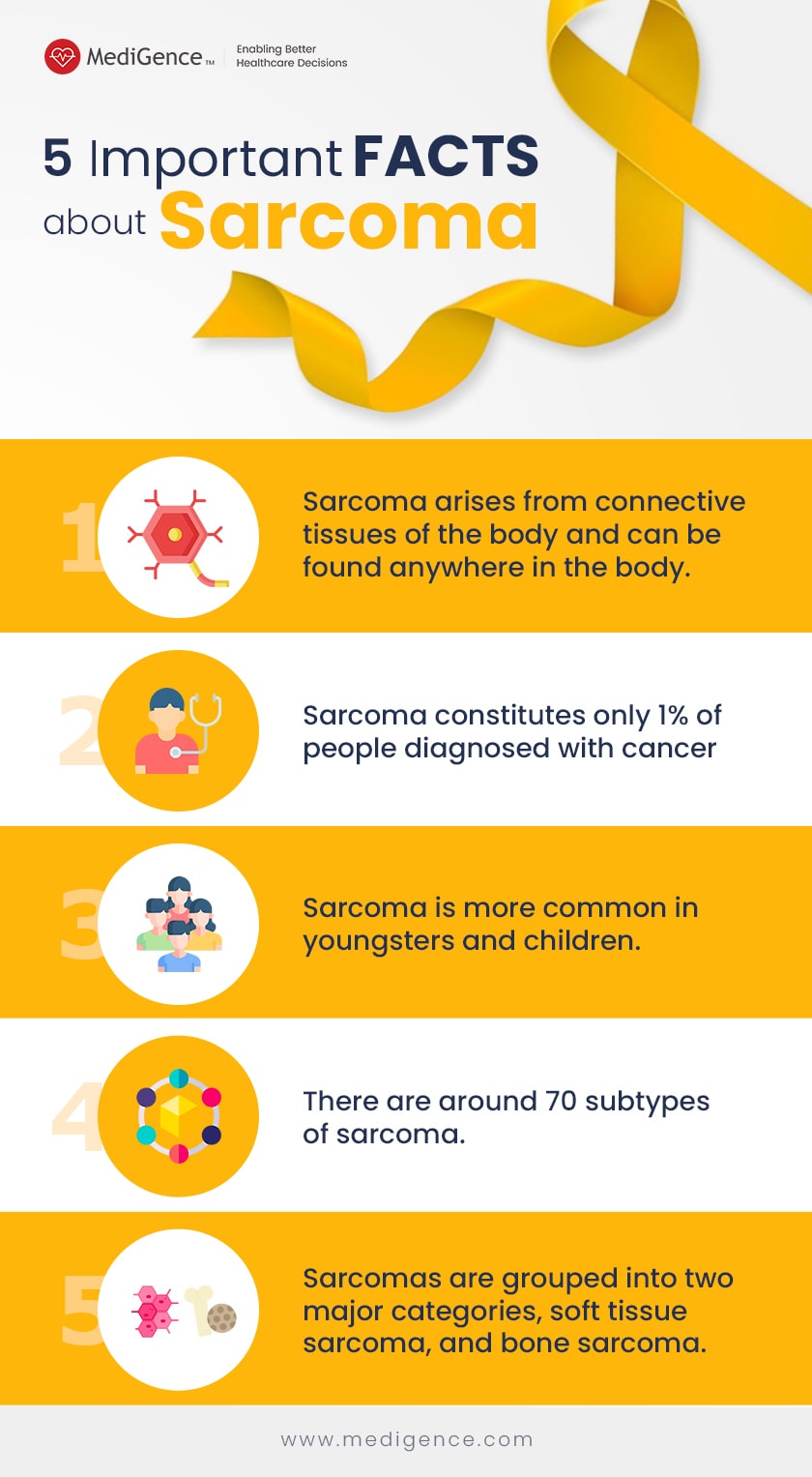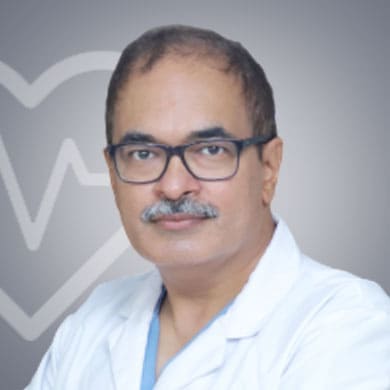Apollo Hospital
Chennai,India

The entire month of July is observed as “Sarcoma Awareness Month”. If you or your loved one has been diagnosed with sarcoma, it is best to know some of the intricacies of this rare form of cancer. Since sarcoma is relatively uncommon, it is often called the “forgotten cancer”. This warrants the need for “Sarcoma Awareness Month” which is celebrated every year in July to raise awareness about sarcoma and its treatment.
Sarcoma is a type of cancer that originates in connective tissues of the body. These include your bones, cartilage, muscles, fatty tissue, fibrous tissue, and blood vessels. Since these tissues are present in different places in the body, sarcoma can occur anywhere. But, it is most commonly found in hands, legs, arms, neck, head, hips, chest, abdomen, and shoulders. Around 60% of sarcomas begin in the leg or arm, 30 % are found in the abdomen whereas 10% begin in the neck or head.
Depending on the cancer’s origin, sarcomas can be of different types. For example, liposarcoma occurs in fat, rhabdomyosarcoma occurs in muscles, and osteosarcoma occurs in bones. Each sarcoma subtype has characteristics that distinguish it from others. Also, some sarcomas can grow faster than others making them more severe and difficult to contain. The type and severity of cancer will help the sarcoma specialist to choose the best possible sarcoma cancer treatment for you. Owing to the beginning of sarcoma awareness month, you may come across a lot of information regarding sarcoma. So, it is best to consult a Sarcoma specialist before choosing the ideal sarcoma cancer treatment.
Though there are around 70 subtypes of sarcomas, they can be classified into two major types: soft tissue sarcoma and bone sarcoma.
The beginning of “Sarcoma Awareness Month” can be traced back to November 2007. During this time, a group of advocates in Seattle came together to unite all the sarcoma non-profits. Collectively, they decided that a separate month needs to be dedicated to bringing awareness about sarcoma. This initiative was supported by a group of doctors at sarctrials.org. These doctors were determined to wipe out sarcoma. Thus, a petition to gather 100,000 signatures for officially declaring July as Sarcoma awareness month was sent to the White House. Eventually, “Sarcoma Awareness Month” was created.
Sarcoma awareness month is important because it brings attention to an often neglected but lethal cancer. Most people are unaware of this particular form of cancer. This limits people’s interest in researching it. By celebrating “sarcoma awareness month”, we can encourage people to explore this under-researched cancer. This can help advance medicine and save the lives of many children. Such events also provide the much-needed support that cancer fighters need to handle the difficulties and uncertainties of sarcoma.

In the early stage, some sarcomas may form a small, painless lump. These lumps can grow in any region of your body. As this small lump grows, it will begin to press on your muscles, nerves, or organs. When this happens, you may start to notice sarcoma symptoms such as pain, breathing problems, and feeling full.
Some of the common symptoms associated with sarcoma are:
If you are worried about any of the changes that you may be experiencing, please talk to your doctor. In case you are diagnosed with sarcoma, consult a sarcoma specialist who can provide you with the best possible sarcoma cancer treatment.
It is not yet clear what exactly causes sarcoma. Most cancers occur because of errors or changes in the DNA of cells. Such cells begin to divide abnormally and grow out of control, eventually forming tumors. As the tumor grows in size, it spreads to nearby tissues and other locations in the body where it forms new tumors. This process is called metastasis. Though the process of how cancer spreads is known, the reason why healthy cells become sarcoma is still unclear.
Even so, scientists have found certain risk factors that can increase the possibility of a person developing sarcoma. Some of these factors are:
One of the most important aims of “sarcoma awareness month” is to bring information about the risk factors of sarcoma to the forefront. This helps in the early diagnosis and treatment of sarcoma.
According to the National Cancer Institute, the occurrence of sarcomas is underestimated because sometimes they can be difficult to distinguish from other cancers, especially when found within organs. Most of the lumps we get are harmless. But, people should get them checked out by a doctor. If your doctor suspects you of having sarcoma, you will need to get the following tests done:
Choosing the best sarcoma treatment is influenced by several factors like the type of sarcoma, its aggressiveness, location, and if it has spread to other parts of the body. Most sarcomas are treated by surgery. But, the best sarcoma treatment plan will be decided by you and your sarcoma specialist. Some of the treatment options for sarcoma are:
Since there is no known cause of sarcoma yet, the only way to prevent it is to avoid exposing yourself to some of the risk factors of sarcoma such as herbicides, radiation, etc. But this is not possible for everyone as people with other cancers will need to undergo radiation therapy. Also, most people with soft tissue sarcoma have not been necessarily exposed to the risk factors. Thus, doctors have very little advice to give when it comes to preventing sarcoma.
Though no test can detect sarcoma cells when they first start to divide, early diagnosis can improve your chances of survival. Thus, this sarcoma awareness month, we urge you to contact your doctor immediately if you begin to notice any lumps on your body. These may be harmless but it is better to get them checked out if they become painful or grow in size.
MediGence can help you discover the right cancer specialist for your sarcoma cancer treatment. It is a global healthcare platform that enables you to choose the right specialist from its network of over 8000 doctors present in more than 25 countries around the world. During the treatment process, you will be provided with the necessary information to make the best healthcare decision. The entire process will be hassle-free and transparent. MediGence helps you:
Chennai,India
In the year 1983 Apollo Hospitals Chennai- the flagship hospital was established. They were the first to nurture the idea in the nation to not only provide holistic healthcare but uplift it to be the face of international standards catering to individual reach and capacities. They have worked tirelessly to catapult education, research and healthcare to reach its best times in the nation.
Strategically located, hotels near Apollo hospital Chennai is very easy to locate. The hospital h... Read More
140
PROCEDURES
42
DOCTORS in 13 Specialties
20+
Facilities & Amenities
Kolkata,India
Apollo Gleneagles Hospitals in Kolkata is the joint venture between Apollo Group of Hospitals chain of India and Parkway Health from Singapore. It is the only hospital to be accredited with the prestigious Joint Commission International (JCI), an international benchmark for quality treatments in the Eastern zone of the Indian subcontinent after a thorough evaluation procedure of testing safety and quality consistency parameters.
In six different categories it has received the much co... Read More
138
PROCEDURES
36
DOCTORS in 13 Specialties
20+
Facilities & Amenities
Bangalore,India
Gleneagles Global Hospital is a premium provider of Healthcare services in India through its chain of multi-super specialty hospitals offering tertiary and quaternary healthcare services with over 2,000 beds and state-of-the-art, world-class hospitals in Hyderabad, Chennai, Bangalore, and Mumbai. Gleneagles Global Hospital is a pioneer in Kidney, Liver, Heart and Lung Transplants. Gleneagles Global Hospitals is a specialist provider of Multi-organ transplant services for patients not just fr... Read More
116
PROCEDURES
29
DOCTORS in 14 Specialties
20+
Facilities & Amenities

Cancer Specialist - Medical Oncologist
Fortis Flt. Lt. Rajan Dhall Hospital , Delhi,India
16 Years of experience
A surgeon par excellence, Dr. Amit Bhargava qualifies as among the most sought after Oncologist in the New Delhi, India. A doctor with outstanding credentials, the doctor is known to guarantee efficiency and safety when performing different kinds of procedures as he keeps abreast of latest developments in his specialty. The specialist holds a very degree of experience with over 16 years of experience. Some o... View bio

Cancer Specialist - Surgical Oncologist
Asian Institute of Medical Sciences , Faridabad,India
10 of experience
Dr. Naveen Sanchety has more than 10 years of experience in the field of surgical oncology. A respected figure in his field, Dr. Sanchety is well-known for delivering evidence-based care to his patients. He provides comprehensive cancer care and employs a patient-centric approach to obtain the best results for his cancer patients. Over the years, he has gained proficiency in performi... View bio

Mumbai's well-known surgical oncologist is Dr. Akash Dhuru. He has performed cancer surgeries and treated breast cancer for more than 16 years. He has been a dedicated surgical oncologist with more than 7 years of surgical oncology experience having performed multiple cancer surgeries with a special interest in Head and Neck, Breast and Gynecological cancers. He also expertise in general oncological proce... View bio
The “yellow color ribbon” represents sarcoma. The ribbon is commonly used in July which is sarcoma awareness month to raise awareness about the condition.
The survival rate of sarcoma cancer depends on the stage and type of sarcoma. In general, the overall 5-year rate of survival for sarcoma is estimated to be 65%.
The most common types of sarcomas are soft tissue sarcomas and bone sarcomas. There are also 70 subtypes of sarcoma found within these major categories.
The exact cause of sarcoma is unknown, But, researchers believe that just like other cancers, sarcomas can also develop because of changes in the DNA of our cells.
Once it begins to metastasize, sarcoma can spread to different locations in the body. The most common being lungs.

An avid traveller, with a healthcare background. Been writing since my young college days, in and around healthcare and medical topics. I love to read, learn more, and impart the same further into more readers. Experienced writing mind with hands on experience in writing blogs and quora answers around medical topics.
(+1) 424 283 4838